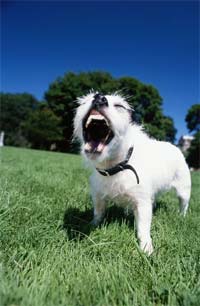
|

What is Dog Fear Aggression? And How to Deal with it
 |
Dog Aggression Out Of Control? Dog Training | Sit Stay Fetch™ |
Dog fear aggression is the direct result of a dog's fear. Just like their human counterparts, dogs have the ability to fear and can develop phobias towards certain elements. This is typically the case with dogs that have a history of abuse or neglect, but keep in mind that any dog can develop a fear. As with most humans, these fears are often irrational, but they may run deep and require a great deal of effort and training to completely dismiss.
Often, when dogs become scared, they tend to lash out aggressively as a form of defense. Depending on the fear, your dog may potentially become aggressive to dogs or humans that it deems threatening. In most instances of this aggression, the dog or human is not doing anything to directly threaten the dog, they just happen to be in the wrong place at the wrong time. Sadly, these attacks can lead to a great deal of pain and anguish, causing many animals to be put down annually.
Before you can begin to address the aggressive behavior, you must first find the root of the problem: the fear. Once the fear has been identified, it can be addressed. Consider seeking help from a professional in this matter. Often, a visit to a veterinarian behaviorist can save both you and your dog a great deal of frustration in attempting to find the fear and its root. A veterinarian behaviorist is an individual who works exclusively with the behaviors of dogs. Do not mistake these professionals from so-called pet psychics and others who believe to be able to commune with animals.
After you have identified the fear, the next step is to address the fear. Instead of exposing the dog directly to the specific agent that causes this fearful behavior, create a sense of security. Gradually expose the fear element on a small level and counteract the fear by praising and petting the animal. If necessary, you may need to muzzle the animal to prevent biting. For example, if your animal is scared of loud noises, slowly introduce him to noises while gradually increasing the volume. This treatment will allow the dog to understand that the noises will not cause harm, thus allow the dog to stop his aggressive behavior.
One thing you should be sure to avoid is to punish the dog's aggressive behavior. In many instances, traditional forms of punishment can only lead a deeper sense of fear, which can directly impact the behavior. Instead, look to praise the dog for his good behavior and minimize the instances that the dog is introduced to the fear itself. Furthermore, in these instances where the fear agent is introduced, be sure to have proper control of your dog on a leash or some other restraint and, if necessary, muzzle your dog to prevent snapping or biting. By working with your dog to find the root of the fear and eliminate all aggressive behavior, you will be able to ensure your dog is healthy and does not pose a threat to other animals or humans.
 |
 |
|
|